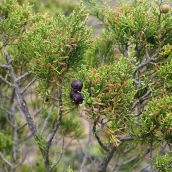Sabina canaria (Juniperus turbinata ssp. canariensis)
Tree to around 6-8 m in height, the trunk sometimes leaning because of constant wind action. Adult leaves are scale-like, almost triangular, short and appressed, while those of young plants strongly resemble the needle-shaped leaves of Juniperus cedrus. Inflorescences are terminal and very tiny. Fruits (galbulus or fruit of the cypress) are round, up to 1.2 cm in diameter, and reddish-brown when ripe. Juniperus turbinata is principally a Mediterranean species, while the subspecies, J. canariensis, is only found in Madeira (including Porto Santo) and the Canaries (central and western islands). A thermophile usually found in juniper forests in the islands, although distribution is much diminished due to human activity. Despite this, well-preserved sizeable formations of this species can still be seen in La Gomera and El Hierro. Its range extends from sea level to 1,100 m, although there have been past mentions of isolated specimens in Las Cañadas, at nearly 2,000 m; it is most common between 300 and 700 m. The sabina or juniper is the plant symbol of El Hierro and has been used for medicinal purposes, among others. In El Hierro, in particular, its wood was used for roof construction.













